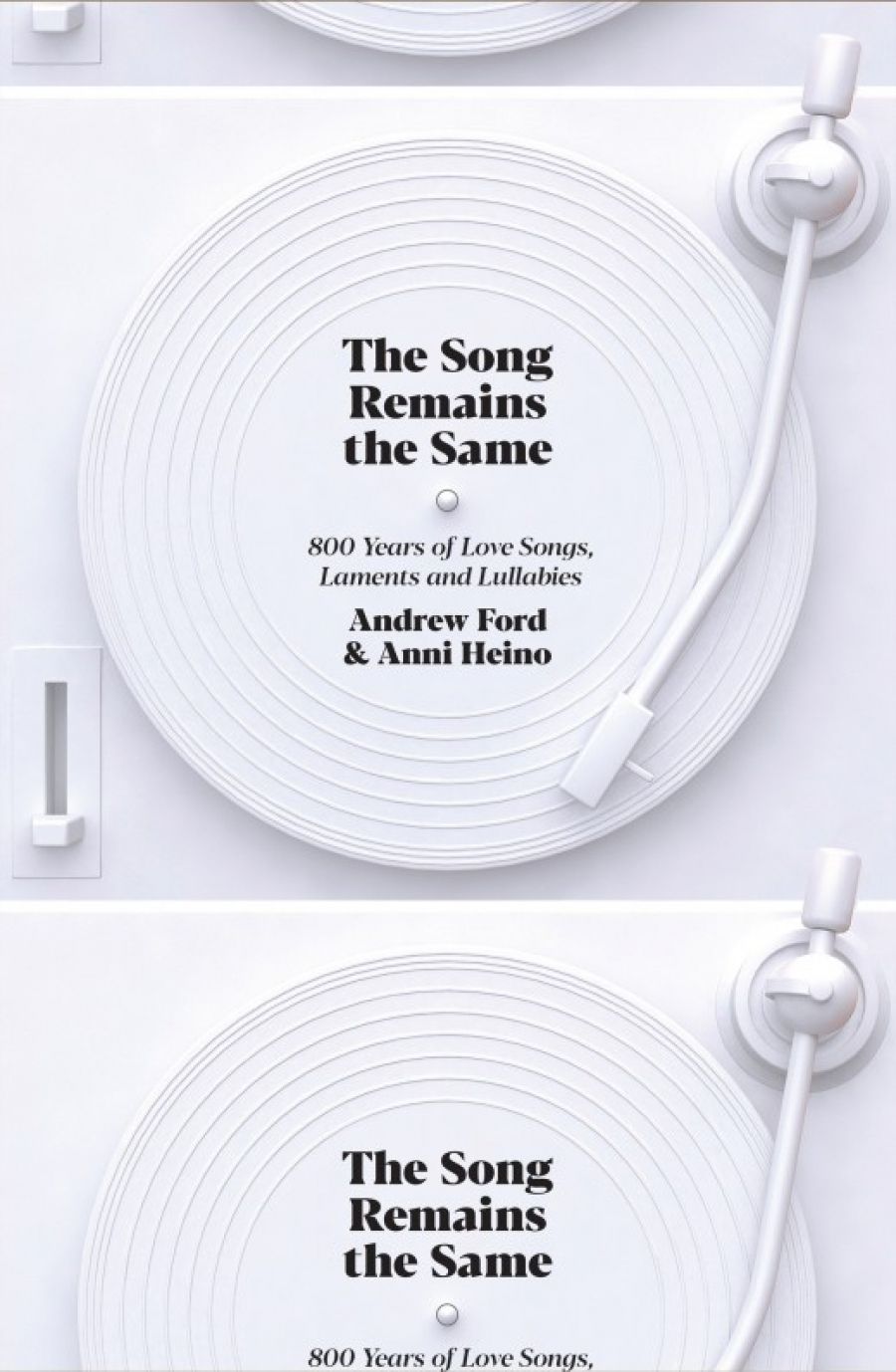
- Free Article: No
- Contents Category: Music
- Review Article: Yes
- Custom Highlight Text:
In 1973, aged six, I heard the song ‘Rock On’ by David Essex. I was obsessed by its sound. While I couldn’t have put it into words, I half understood that the song was made sonically exciting not just through its inventive arrangement (a song about rock and roll with no guitars!) but also its production techniques, especially the use of reverb and delay to ‘stage’ the vocal and instrumental performances.
- Featured Image (400px * 250px):

- Book 1 Title: The Song Remains the Same
- Book 1 Subtitle: 800 years of love songs, laments and lullabies
- Book 1 Biblio: La Trobe University Press, $32.99 pb, 288 pp
David Essex’s ‘Rock On’ is one of millions of songs not discussed by Ford and Heino. The authors themselves list numerous songwriters they reluctantly excluded. But this book, despite its range, is not an encyclopedia of song, nor is it about ‘liking or disliking individual songs’. Just as they are vehicles for their performers, so these songs are vehicles for Ford and Heino, allowing them to discuss not only the individual song in question, but also scores of others, illustrating how song can be understood in sociological and biographical ways, as well as strictly musicological ones.
 Marlene Dietrich for the film Shanghai Express, 1932. She sings 'Lili Marlene', a song appearing in the book (photograph by Don English)
Marlene Dietrich for the film Shanghai Express, 1932. She sings 'Lili Marlene', a song appearing in the book (photograph by Don English)
While Ford and Heino write compellingly about the simplest of material (‘You Are My Sunshine’, for instance), they shine when discussing songs that are musically a little odd: ‘Stardust’, ‘America’, ‘Lush Life’, ‘Night and Day’, ‘Fast Car’. The last of these, by Tracy Chapman, provides one of the collection’s many high points. Ford and Heino give a stunning reading of the song, one far more complex than its hypnotically repetitive guitar part might suggest.
As the essay on ‘Fast Car’ shows, Ford and Heino can walk the line between scholarly analysis, which requires musicological knowledge beyond the general reader, and popular music journalism, which too often focuses unduly on the lyrical content of a song. As well as being able to explain the role played by harmony and structure, Ford and Heino can also brilliantly elucidate those moments – especially prominent in vernacular and popular song – that resist conventional analysis: a particular inflection, a yelp, whatever.
Ford and Heino have a genius for uncovering intertextual connections that most of us would miss. Some of these links concern musical borrowings. John Lennon, for instance, reworked a riff by Bobby Parker in ‘I Feel Fine’. The famous alto sax solo from Gerry Rafferty’s ‘Baker Street’ lifts (and transforms) Steve Marcus’s soprano sax part from ‘Half a Heart’. But Ford and Heino go well beyond such debts. Throughout the book they trace complex transnational and transhistorical connections between apparently divergent material. For instance, the essay on ‘Thule, the Period of Cosmography’ by Thomas Weelkes (the Elizabethan composer who once urinated on the dean of Chichester Cathedral from the organ loft) becomes an occasion to discuss the role of long and outré words in song lyrics.
Of course, songs make more immediate connections in time and space, most notably between performers and audiences. Even when we are alone, when we hear a song that we know we often begin to sing. This social element of song is powerfully present in The Song Remains the Same. It is seen in the discussion of explicitly relational and collective song forms, such as lullabies, hymns, and anthems, as well as the social practices associated with songs. The essay on Queen’s ‘We Will Rock You’, for instance, teases out that song’s relationship with the call-and-response form of work songs.
The emphasis on communities is also seen in the essays concerned with the political power that song can engender, found in tracks such as ‘Gracias a la Vida’, by the Chilean songwriter Violeta Parra, and ‘Strange Fruit’, the extraordinary song about lynching made famous by Billie Holiday. (Women, so often sidelined in music – both ‘élite’ and ‘popular’ – are impressively present throughout these pages.)
The essays in The Song Remains the Same, then, are not merely randomly organised but are connected through the book’s numerous repeating themes. There are also links (often playful) between contiguous essays. For instance, the essay on Kate Bush’s ‘Oh England My Lionheart’ is followed by an essay on ‘Ja nus hons pris’ by Richard the Lionheart. The whole book is organised like a perfectly sequenced playlist. Indeed, Heino’s companion Spotify playlist is an invaluable resource for readers of this book.
Song is culturally central in large part because of its affective power. What other form can so quickly produce such intense and various somatic responses? Songs make us cry, laugh, and dance. But more cerebral responses are equally important, as this stunningly good book shows. Ford’s and Heino’s essays are not only full of insights about individual songs, classes of songs, and song in general, but they are also full of jokes and wit. They are masterclasses in the short-essay form. Like a good song, they are brief, memorable, and compelling. Here’s hoping for a Song Remains the Same 2, with an essay about ‘Rock On’.


Comments powered by CComment